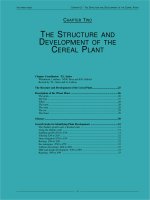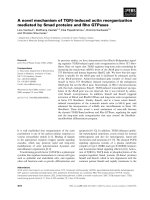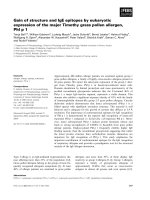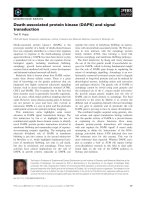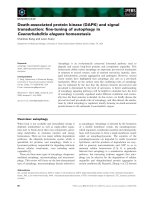Structure and mechanism of hormone perception and signal transduction by abscisic acid receptors
Bạn đang xem bản rút gọn của tài liệu. Xem và tải ngay bản đầy đủ của tài liệu tại đây (14.19 MB, 171 trang )
STRUCTURE AND MECHANISM OF HORMONE
PERCEPTION AND SIGNAL TRANSDUCTION BY
ABSCISIC ACID RECEPTORS
NG
LEY MOY (HUANG LIMEI)
B.Sc. (Hons.), Nanyang Technological University
A THESIS SUBMITTED FOR THE DEGREE OF
DOCTOR OF PHILOSOPHY
NUS GRADUATE SCHOOL FOR INTEGRATIVE
SCIENCES AND ENGINEERING
NATIONAL UNIVERSITY OF SINGAPORE
2013
DECLARATION
DECLARATION
I hereby declare that this thesis is my original work and it has been
written by me in its entirety. I have duly acknowledged all the sources of
information which have been used in the thesis.
This thesis has also not been submitted for any degree in any university
previously.
_____________________________________
NG LEY MOY
25 June 2013
ACKNOWLEDGEMENTS
ACKNOWLEDGEMENTS
First and foremost, I would like to express my gratitude to my
supervisors, Professor Yong Eu Leong, Dr Eric Xu and Dr Karsten Melcher
for providing me the opportunity to embark on this valuable research
experience and nurturing me over the years. I appreciate the unfailing support
from my main supervisor Professor Yong and co-supervisor Dr Li Jun,
allowing me to pursue and explore alternative topics of interest and giving me
advice and assistance when needed. I have been deeply inspired by my
mentors, Dr Eric Xu and Dr Karsten Melcher whom I have benefitted
immensely from under their close guidance during my attachment in Van
Andel Institute (VAI).
I would like to acknowledge and thank NGS for providing me with the
4-year PhD scholarship as well as approval and additional financial support
allowing me to perform my research in VAI under the “2+2” collaborative
scheme. I would also like to acknowledge the Department of Obstetrics &
Gynaecology for hosting and supporting my studies in NUS. I would like to
thank my TAC chairperson, Assoc. Prof. K Swaminathan and TAC member,
A/Prof. Gong Yinhan for their advice in my PhD qualifying examination and
thesis.
I am deeply grateful to VAI for hosting my overseas attachment. The
two years I spent working in VAI has been one of the most valuable and
memorable experiences in my life so far. I have met many wonderful people
who have helped me in my work and/or made my overseas living a smooth
and enjoyable experience. I appreciate Margie, Ajian, Gao Xiang and Cathy
for their help with my settling-in at the new location. I am thankful to Kelly
ACKNOWLEDGEMENTS
for her patience and kindness in teaching me the basic techniques when I first
started working in VAI. I am grateful to be part of the “ABA team”, consisting
of Dr Eric, Dr Karsten, Dr Edward, Jasmine, Amanda, Kelly and Dr Xu Yong,
in which we have worked closely and tirelessly to stay ahead in the intense
competition. I would like to thank all members of Dr Eric Xu’s lab for being
such helpful and approachable colleagues. I have made many friends during
my stay in Grand Rapids, who have given me much fun, laughter and
encouragement. Although I regret that I am not able to list all of them here, I
would make a special mention to Amanda, Kelly, Jennifer, Shiva, Kuntal,
Krishna, Ting Ting, Jasmine, Eileen, Xiaodan, Lili, Cynthia and AK. I was
also deeply touched by the warm reception and sumptuous delicacies I have
received from the families of Amanda, Karsten, Eric, Ajian and Jinming in
their homes. Many thanks for the wonderful times!
Back in my Singapore homeland, I have been treated to a warm
welcome by the lab of Professor Yong. I am fortunate to have worked with my
wonderful colleagues Dr Inthrani, Dr Sun Feng, Bao Hui, Ryan, Vanessa,
Seok Eng and Zhi Wei, all whom I have became friends with. Thanks for
always being very helpful and offering a listening ear whenever I needed.
I would also extend my gratitude to everyone else who have supported
me in one way or another, including my previous mentors and colleagues.
Also, a special mention here to Kah Ying and Terence.
Last but not least, I would like to thank my family and friends for
being understanding and encouraging when I had been away from them in the
pursuit of my PhD. Thanks for believing in me and standing by me. Finally, I
would like to dedicate this thesis to my parents and brothers.
TABLE OF CONTENTS
TABLE OF CONTENTS
DECLARATION i
ACKNOWLEDGEMENTS ii
TABLE OF CONTENTS iv
SUMMARY vii
LIST OF TABLES ix
LIST OF FIGURES x
LIST OF ABBREVIATIONS xii
LIST OF PUBLICATIONS xiv
CHAPTER 1 LITERATURE REVIEW 1
1.1 Introduction 2
1.2 Physiological role of ABA in abiotic stress tolerance 4
1.3 Biosynthesis and transport of ABA 6
1.4 Catabolism of ABA 8
1.5 Chemical features of ABA 11
1.6 Components and model of the core ABA signalling pathway 13
1.6.1 PP2Cs negatively regulate ABA signalling 13
1.6.2 SnRK2s mediate the ABA response 16
1.6.3 ABA regulation of ion channels 20
1.6.4 ABA regulation of gene expression 20
1.6.5 Putative ABA receptor candidates 23
1.6.5.1 Flowering Time Control Protein A (FCA) 23
1.6.5.2 Magnesium chelatase H subunit (CHLH) 24
1.6.5.3 G-protein-coupled receptor 2 (GCR2) 25
1.6.5.4 GPCR-type G proteins (GTG1, GTG2) 25
1.6.6 Discovery of PYLs as ABA receptors 26
1.6.6.1 Chemical genetic screen using pyrabactin 28
1.6.6.2 Identification of PYLs as PP2C interactors 29
1.6.6.3 Helix-grip fold receptors 32
1.6.7 Model of the core ABA signalling pathway 33
1.7 Aims, objectives and significance of the study 35
TABLE OF CONTENTS
CHAPTER 2 MATERIALS AND METHODS 38
2.1 Plasmid construction 39
2.2 Protein expression and purification 40
2.2.1 Small scale expression of tagged recombinant proteins 40
2.2.2 Large scale purification of untagged proteins 41
2.3 Protein crystallization 42
2.4 Data collection and structure determination 44
2.5 Assays for the interactions between PYLs and PP2Cs 45
2.6 Assays of PP2C phosphatase activity 46
2.7 Radio-ligand binding assay 47
2.8 Mutagenesis 47
CHAPTER 3 RESULTS 49
3.1 Preparation of recombinant proteins 50
3.1.1 Amino acid sequence analysis 50
3.1.2 Small scale expression of recombinant proteins 55
3.2 ABA-dependent interactions of PYLs with PP2Cs 57
3.3 Large scale purification and crystallization of PYLs 60
3.4 Molecular features of PYLABA interaction 64
3.4.1 Overall structures of apo PYL1 and PYL2 64
3.4.2 Structure of ABA-bound PYL2 67
3.4.3 Basis for stereoselectivity 71
3.4.4 Conformational changes upon ABA binding 72
3.5 Mechanism of ABA-induced PYL binding and inhibition of PP2C 74
3.5.1 Overall structure of apo PP2C 75
3.5.2 Structures of the PYL2ABAPP2C complexes 75
3.5.3 A gate-latch-lock mechanism of signalling by ABA receptors . 78
3.6 Selective pyrabactin activation and antagonism of PYLs 83
3.6.1 Mechanism of pyrabactin-mediated receptor activation 86
3.6.2 Mechanism of PYL2 antagonism by pyrabactin 89
3.6.3 I137V converts PYL1 to a pyrabactin-inhibited receptor 91
3.6.4 A93F converts PYL2 to a pyrabactin-activated receptor 93
TABLE OF CONTENTS
CHAPTER 4 DISCUSSION 97
4.1 Collective structural studies of the PYL ABA receptors 103
4.2 Development of novel ABA receptor agonists 109
4.3 Identification of ABA receptor antagonism 111
4.4 Ligand-independent receptor activation 112
4.5 Agricultural applications 114
4.6 Elucidating the complete core ABA signalling pathway 116
4.6.1 Regulation of SnRK2 by PP2C 117
4.6.2 PP2C catalytic mechanism 119
4.6.3 Mechanism of SnRK2 autoactivation 119
4.7 Human homologues of the core ABA signalling proteins 123
4.7.1 START domain proteins 123
4.7.2 Human protein phosphatases 130
4.7.2.1 Protein phosphatases classification 130
4.7.2.2 Human PP2Cs 131
4.7.3 AMPK- The mammalian homologue of SnRK 137
4.8 Conclusions and perspectives 139
REFERENCES 140
SUMMARY
SUMMARY
Adverse environmental conditions are a threat to agricultural yield, which in
turn affect livelihood, health and economy worldwide. Abscisic acid (ABA) is
a vital plant hormone that regulates abiotic stress tolerance, allowing plants to
cope with environmental stresses. Upon ABA induction, several members of
Snf1-related protein kinases (SnRKs) are activated and mediate the ABA
response. Under basal conditions, a group of type 2C protein phosphatases
(PP2Cs) act as negative regulators to silence the ABA signalling pathway,
apparently by inhibiting SnRKs. The identity of the ABA receptor has been
controversial until at least 2 recent studies independently discovered the same
group of 14-member PYR/PYL/RCAR (in this thesis referred to as PYL for
simplicity) family to be the likely ABA receptors. It has been proposed that
ABA induces PYLs to inhibit PP2Cs, resulting in the activation of SnRKs and
the ABA response, although the mechanisms have been unknown.
In this study, the structures of representative PYLs in apo and ABA-bound
forms were determined using X-ray crystallography, providing evidence for
the role of PYLs as ABA receptors. Comparison of the structures of ABA-
bound and unbound receptors revealed conformational changes in 2 receptor
loops, termed ‘gate’ and ‘latch’ loops, upon hormone binding. The functional
importance of these loops and key pocket residues involved in ABA
recognition were validated by biochemical assays of mutant receptors.
Subsequently, the structures of representative apo PP2C and
PYLABAPP2C complexes were determined. Analyses of these structures
SUMMARY
revealed that while the overall PP2C conformation remains unchanged in PYL
interaction, the receptor undergoes ABA-induced structural changes in the
gate and latch regions that promote PP2C binding. In the PYLABAPP2C
structure, a conserved PP2C tryptophan residue inserts into the PYL pocket,
acting as a molecular lock that stabilizes the receptor-phosphatase interaction.
In this conformation, PYL sterically blocks the PP2C active site, which
explains for the ABA-induced PYL inhibition of the phosphatase. Hence, we
identified a ‘gate-latch-lock’ mechanism of hormone binding and signal
transduction by the PYL ABA receptor. These structural observations were
supported by interaction and phosphatase activity assays with mutant PYLs
and PP2Cs.
Consistent with previous findings, we showed that pyrabactin, a synthetic
ABA agonist, selectively activates or inhibits specific members of the PYL
family. Here, the crystal structures of representative pyrabactin-activated and
pyrabactin-antagonized PYL complexes were determined. Comparison of
these structures revealed the molecular mechanisms underlying the selective
PYL activation and repression, providing a basis for future design of specific
ABA receptor agonists and antagonists.
Together, these data contribute significantly to the understanding of the
molecular mechanisms controlling ABA responses. Such advancement will be
valuable for developments in plant biotechnology to solve worldwide
agriculture-implicated issues and may also contribute to the understanding of
similar intracellular signalling mechanisms in humans.
LIST OF TABLES
LIST OF TABLES
Table 1. List of crystallization conditions 43
Table 2. List of proteins in the study, their expressed regions and calculated
properties 54
Table 3. Statistics of structure refinement for apo PYLs, ABI2 and ABA-
bound complexes. 65
Table 4. Statistics of structure refinement for pyrabactin-bound complexes. 88
Table 5. Structural studies of PYLs in ABA signal transduction. 105
Table 6. Interactions between functional groups of ABA and pyrabactin with
receptor residues. 106
Table 7. Percent amino sequence identity between START domains of
Arabidopsis PYLs and human STARD proteins. 125
Table 8. Statistics of structural comparison between PYL2 and human STARD
proteins 127
Table 9. Percent amino sequence identity between Arabidopsis and human
PP2C domains 133
Table 10. Statistics of structural comparison between Arabidopsis and human
PP2C domains 133
LIST OF FIGURES
LIST OF FIGURES
Figure 1. ABA confers abiotic stress tolerance in plants 5
Figure 2. ABA biosynthetic pathway 7
Figure 3. ABA catabolic pathways. 10
Figure 4. Chemical structures of ABA stereoisomers, structural analogue and
pyrabactin 12
Figure 5. Classification of Arabidopsis PP2Cs 14
Figure 6. Classification and domain structure of Arabidopsis SnRK2 19
Figure 7. Phylogenetic tree of the 14 members of the Arabidopsis PYL/RCAR
family. 30
Figure 8. Model of the core ABA signalling pathway 34
Figure 9. Schematic representation of the Amplified Luminescent Proximity
Homogenous Assay (ALPHA) Screen 46
Figure 10. Amino acid sequence alignment of PYLs. 51
Figure 11. Amino acid sequence alignment of group A PP2Cs. 53
Figure 12. Small scale expression of recombinant PYLs. 56
Figure 13. Small scale expression of recombinant PP2Cs 56
Figure 14. AlphaScreen assay of PYL proteins interactions with PP2Cs 58
Figure 15. PYL2 binds to and inhibits HAB1 in an ABA-dependent manner.59
Figure 16. Large scale purification of PYL2. 62
Figure 17. Large scale purification of PYL1. 63
Figure 18. Crystals of the apo and ABA-complexed PYL receptors 63
Figure 19. Structures of the apo ABA receptors 66
Figure 20. Structures of the ligand-free and ABA-bound PYL2. 68
Figure 21. Intermolecular interactions in the ABA-bound PYL2 pocket 69
Figure 22. Mutational analysis of the ABA-binding pocket 70
Figure 23. Stereoselectivity of the ligand binding pocket. 71
Figure 24. A gate and latch mechanism in ligand-binding. 73
Figure 25. Crystals of the apo PP2C and in complexes with the ABA-bound
PYL2 receptor 74
Figure 26. Structures of the PP2Cs 76
Figure 27. Structures of the PYL2ABAPP2C complexes. 77
Figure 28. The HAB1PYL2 interaction interface 80
Figure 29. DimPlot analysis of interactions in the PYL2HAB1 interface. 81
Figure 30. Mutational analysis of PYL2 and HAB1 interface 82
LIST OF FIGURES
Figure 31. Selective activation of PYL receptors by pyrabactin. 84
Figure 32. Pyrabactin reverses the ABA-induced activation of PYL2 85
Figure 33. Structure of the PYL1pyrabactinABI1 complex 87
Figure 34. The PYL2pyrabactin structure. 90
Figure 35. I137V converts PYL1 into a pyrabactin-inhibited receptor. 92
Figure 36. A93F converts PYL2 to a pyrabactin-activated receptor. 95
Figure 37. The PYL2 A93Fpyrabactin agonist complex structures. 96
Figure 38. Cartoon summary of the gate-latch-lock mechanism of ligand
perception and signal transduction by the PYL ABA receptors. 99
Figure 39. Mutations in the PYR1 latch and gate affect ABA signalling in
vitro and in vivo. 101
Figure 40. PYL functional motifs and residues in ABA receptor activity 108
Figure 41. Identification of novel ABA receptor agonists 110
Figure 42. ABA-independent PYL5HAB1 interaction. 113
Figure 43. Mechanism of PP2C inhibition of SnRK2. 118
Figure 44. HAB1 catalytic mechanism 120
Figure 45. Structures of SnRK2.3 and SnRK2.6. 122
Figure 46. Phylogenetic tree and domain organizations of the 15 human
START domain proteins 125
Figure 47. Multiple sequence alignment of the START domains of
Arabidopsis PYL and human STARD proteins 126
Figure 48. Structures of human STARD proteins and their overlay with
Arabidopsis PYL2 129
Figure 49. Multiple sequence alignment of the PP2C domains of Arabidopsis
and human PP2C proteins 135
Figure 50. Structural similarity between Arabidopsis ABI2 and human PP2Cs.
136
LIST OF ABBREVIATIONS
LIST OF ABBREVIATIONS
AAO3 Abscisic aldehyde oxidase
ABA Abscisic acid
ABAGE
ABA glucosyl ester
ABF ABRE-binding factor
ABI ABA-insensitive
ABRE ABA-responsive element
AGI Arabidopsis Genome Initiative
AMPK Adenosine monophosphate (AMP)-activated protein kinase
AREB ABRE-binding protein
cDNA Complementary DNA
CDPK Calcium-dependent proteins kinase
Da Dalton
DMSO Dimethyl sulfoxide
DNA Deoxyribonucleic acid
DPA Dihydrophaseic acid
EC
50
Half-maximal effective concentration
ER Endoplasmic reticulum
GST Glutathione-S-transferase
HAB Homology to ABI
HSQC Heteronuclear single quantum coherence
IC
50
Half-maximal inhibitory concentration
IPTG Isopropyl -D-1-thiogalactopyranoside
ITC Isothermal titration calorimetry
K
d
Dissociation constant
LIST OF ABBREVIATIONS
kD kilo Dalton
MBP Maltose binding protein
MCS Multiple cloning site
MW Molecular weight
NCED
9cisepoxycarotenoid dioxygenase
NMR Nuclear magnetic resonance
ORF Open reading frame
OST1 Open stomata 1
PA Phaseic acid
PCR Polymerase chain reaction
PI Isoelectric focusing point
PP2C Type 2C protein phosphatase
PYL PYR1-like
PYR1 Pyrabactin Resistance 1
RCAR Regulatory Component of ABA Receptor
RMSD Root-mean-square deviation
SD Standard deviation
SEC Size exclusion chromatography
Snf1 Sucrose nonfermenting
SnRK Snf1-related protein kinase
SPA Scintillation proximity assay
StAR Steroidogenic acute regulatory protein
STARD START domain protein
START Steroidogenic acute regulatory (StAR)-related lipid transfer
ZEP Zeathanxin epoxidase
LIST OF PUBLICATIONS
LIST OF PUBLICATIONS
1. Melcher K, Ng LM
*, Zhou XE, Soon FF, Xu Y, Suino-Powell KM,
Park SY, Weiner JJ, Fujii H, Chinnusamy V, Kovach A, Li J, Wang Y,
Li J, Peterson FC, Jensen DR, Yong EL, Volkman BF, Cutler SR, Zhu
JK, Xu HE. A gate-latch-lock mechanism for hormone signalling by
abscisic acid receptors. Nature. 2009 Dec 3;462(7273):602-8.
2. Melcher K, Xu Y, Ng LM
*, Zhou XE, Soon FF, Chinnusamy V,
Suino-Powell KM, Kovach A, Tham FS, Cutler SR, Li J, Yong EL,
Zhu JK, Xu HE. Identification and mechanism of ABA receptor
antagonism. Nat Struct Mol Biol. 2010 Sep;17(9):1102-8.
3. Ng LM
*, Soon FF, Zhou XE, West GM, Kovach A, Suino-Powell
KM, Chalmers MJ, Li J, Yong EL, Zhu JK, Griffin PR, Melcher K, Xu
HE. Structural basis for basal activity and autoactivation of abscisic
acid (ABA) signaling SnRK2 kinases. Proc Natl Acad Sci U S A. 2011
Dec 27;108(52):21259-64.
4. Soon FF, Ng LM*, Zhou XE, West GM, Kovach A, Tan MH, Suino-
Powell KM, He Y, Xu Y, Chalmers MJ, Brunzelle JS, Zhang H, Yang
H, Jiang H, Li J, Yong EL, Cutler S, Zhu JK, Griffin PR, Melcher K,
Xu HE. Molecular mimicry regulates ABA signaling by SnRK2
kinases and PP2C phosphatases. Science. 2012 Jan 6;335(6064):85-8.
5. Zhou XE, Soon FF, Ng LM
*, Kovach A, Suino-Powell KM, Li J,
Yong EL, Zhu JK, Xu HE, Melcher K. Catalytic mechanism and
kinase interactions of ABA-signaling PP2C phosphatases. Plant Signal
Behav. 2012 May 1;7(5):581-8.
Notes and author contributions:
*Co-first author.
The scope of this thesis is primarily based on publications 1 and 2.
Prof. Yong EL, Dr. Li J, Dr. Xu HE and Dr. Melcher K conceived the project
and supervised research.
Ng LM (contributed key data in publications 1 and 2) and Soon FF
(contributed mostly in publications 3-5) performed most of the research work,
with contributions from all authors.
Dr Zhou XE solved crystal structures.
LITERATURE REVIEW
CHAPTER 1
LITERATURE REVIEW
LITERATURE REVIEW
1.1 Introduction
“There are things known and there are things unknown, and
in between are the doors of perception.”
Aldous Huxley
We are constantly surrounded by signals, for example, traffic signals,
notifications, advertisements and feelings of pain or hunger. However, we are
only aware of these signals if we perceive them. We would not know or
respond if we do not perceive them, even if the signals have been there. Thus,
in the process of conveying a signal, perception of the signal is as important as
existence of the signal itself.
At the cellular level, extracellular signals are often sent to cells through
molecules such as hormones. In plants, the hormone abscisic acid (ABA) is
produced when environmental condition is harsh, to send signals to the plant
cells to adapt as necessary. ABA was discovered in the 1960s and shortly
after, much has been established about its chemistry and physiological
importance (Weiner et al., 2010). In the following decades, more than 100
mediators involved in ABA signalling have been identified in molecular
genetic, biochemical and pharmacological studies (Cutler et al., 2010).
However, for almost half a century, a missing piece of puzzle remains in our
knowledge of ABA signal transduction. That is, how the ABA signal is
perceived.
LITERATURE REVIEW
The identification of ABA receptors, plant proteins that sense the hormone
and relay the signal to other mediators in the pathway, has been a daunting
task full of controversy and frustrations. Since 2006, several reports claimed to
have identified the ABA receptors (McCourt and Creelman, 2008), but none
has been substantiated after further investigations. The turnaround came in
mid 2009 when at least two separate findings convincingly pointed to the
same members belonging to the START-domain superfamily of proteins as
the candidate ABA receptors (Ma et al., 2009; Nishimura et al., 2010; Park et
al., 2009; Santiago et al., 2009b). The 14 members of this group of proteins
are named Pyrabactin Resistance 1 (PYR1) and PYR1-like (PYL1PYL13)
(Park et al., 2009) or Regulatory Component of ABA Receptor
(RCAR1RCAR14) (Ma et al., 2009). For simplicity, this group of
Arabidopsis START-domain proteins are referred to as PYL(s) in this thesis.
The discovery of PYLs as the likely ABA receptors shed light into uncovering
how plant cells perceive and relay the ABA signal, a knowledge that has
valuable agricultural and economic implications.
This literature review focuses on the field of ABA signalling up till the initial
discovery of the PYL proteins as the likely ABA receptors, highlighting the
gaps that were to be addressed by the study presented in this thesis.
LITERATURE REVIEW
1.2 Physiological role of ABA in abiotic stress tolerance
ABA is a vital phytohormone that confers abiotic stress tolerance in plants
(Zhu, 2002). Under stressful environmental conditions such as water shortage,
salinity and temperature extremes, the ABA content in plants rises
significantly, stimulating stress-tolerant effects that help them to cope and
survive in the adverse conditions (Figure 1). It has been demonstrated that
mutant plants engineered with enhanced sensitivity to ABA do better than
their wild type counterparts in drought conditions (Saez et al., 2006). Under
drought or osmotic stress, ABA promotes stomata closure to prevent water
loss through transpiration and the accumulation of osmocompatible solutes to
retain water (Cutler et al., 2010; Kim et al., 2010). It has also been shown that
ABA is required for tolerance to freezing, by the induction of dehydration
tolerance genes (Xiong et al., 2001).
The role of ABA as a negative plant growth regulator has been long
established (Milborrow, 1974). The action of ABA in the induction and
maintenance of seed dormancy is attributed to its potent effects in the
inhibition of seed germination (Lopez-Molina et al., 2001). ABA also inhibits
the growth and development of whole plants or plant parts and counteracts the
effects of growth-stimulating hormones such as gibberellins (Cutler et al.,
2010). The inhibitory effects of ABA on germination and growth help plants
surpass the stress conditions and germinate only when the conditions are
favourable for growth.
LITERATURE REVIEW
Figure 1. ABA confers abiotic stress tolerance in plants.
Overview of the ABA-mediated physiological responses that enable plants to
adapt and survive in harsh environmental conditions.
!
!
LITERATURE REVIEW
1.3 Biosynthesis and transport of ABA
Stress signals induce the expression of enzymes responsible for ABA
biosynthesis. Most of the ABA biosynthesis genes have been identified and
cloned, which includes zeathanxin epoxidase (ZEP), 9cisepoxycarotenoid
dioxygenase (NCED) and abscisic aldehyde oxidase (AAO3) (Xiong et al.,
2001; Xiong et al., 2002). ABA is synthesized from C
40
carotenoids through
several enzymatic steps (Figure 2) (Nambara and Marion-Poll, 2005).
Zeaxanthin, formed from the hydroxylation of -carotene, is converted to
violaxanthin by ZEP. This is followed by the synthesis and oxidative cleavage
of neoxanthin into xanthoxin, the C
15
precursor of ABA. The production of
xanthoxin catalyzed by NCED is thought to be the key regulatory step in ABA
biosynthesis. Xanthoxin is then converted into abscisic aldehyde which is
oxidized into ABA.
The endogenous concentration of ABA is determined by the balance between
ABA biosynthesis and catabolism, as well as the rate of ABA transport to the
site of action. However, the mode of intercellular movement of ABA has been
previously unclear. Although ABA can diffuse passively across biological
membranes, recent evidence suggest that active transporters are involved in
shuttling ABA in and out of cells. One such transporter, AtABCG25, was
identified in a genetic screen of mutants with altered ABA sensitivity
(Kuromori et al., 2010). AtABCG25 is an ATP-binding cassette (ABC)
transporter expressed mainly in vascular tissues where ABA is predominantly
synthesized.
LITERATURE REVIEW
Figure 2. ABA biosynthetic pathway.
ABA is derived from C
40
epoxycarotenoid precursors through oxidative
cleavage reactions in the plastid. The C
15
intermediate, xanthoxin, is exported
to the cytosol where it is converted to ABA through a two-step reaction via
abscisic aldehyde. The ABA biosynthetic enzymes, zeathanxin epoxidase
(ZEP), 9cisepoxycarotenoid dioxygenase (NCED), short-chain alcohol
dehydrogenase and abscisic aldehyde oxidase (AAO3), are shown in pink.
LITERATURE REVIEW
In AtABCG25-expressing membrane vesicles derived from insect cells, ATP-
dependent efflux of ABA was detected, suggesting the role of AtABCG25 as
an ABA exporter. Simultaneously, another ABC transporter, AtABCG40, was
identified to be an ABA importer (Kang et al., 2010). ABA uptake was
increased in cells overexpressing AtABCG40 and decreased in cells with
defective AtABCG40. More recently, another ABA importer, ABA-importing
transporter 1 (AIT1), has been identified (Kanno et al., 2012), additionally
demonstrating the involvement of ABA transporters in the intercellular
transmission of ABA. Thus, a simple model of ABA translocation has been
proposed (Umezawa et al., 2010). In this model, ABA synthesized in vascular
cells are actively transported by ABA exporters into the extracellular
apoplastic space, after which uptake into the sites of action, such as guard
cells, occur through active ABA importers.
1.4 Catabolism of ABA
When stress signals are alleviated, ABA is metabolized into inactive products.
ABA catabolism occurs largely through two types of reaction, hydroxylation
and conjugation. ABA can be hydroxylated on one of the three methyl groups
(C-7’, C-8’ and C-9’) of the ring structure (Figure 3). Of these, 8’-
hydroxylation is thought to be the predominant ABA catabolic pathway
(Cutler and Krochko, 1999). Accordingly, the products of the 8’-
hydroxylation pathway, phaseic acid (PA) and dihydrophaseic acid (DPA) are
the most abundant ABA catabolites. While 8’-hydroxy ABA contains
substantial biological activity, spontaneous cyclization to form PA causes
LITERATURE REVIEW
significant reduction in activity (Zou et al., 1995). PA is further catabolized to
the biologically inactive DPA.
Endogenous ABA levels in Arabidopsis decreases under high humidity
conditions, primarily by ABA catabolism through the 8’-hydroxylation
pathway (Okamoto et al., 2009). ABA 8’-hydroxylation is catalyzed by ABA
8’-hydroxylase, a cytochrome P450 encoded by CYP707A family of genes
(Kushiro et al., 2004; Saito et al., 2004). Transcript levels of the 4 members of
CYP707A family, CYP707A1CYP707A4, are increased under drought stress
and strongly induced upon rehydration (Kushiro et al., 2004), with the highest
induction observed in CYP707A3 (Umezawa et al., 2006). Recent findings
indicated that CYP707A3 functions in vascular tissues to reduce systemic
ABA levels whereas CYP707A1 catabolizes local ABA pools inside guard
cells in response to high humidity (Okamoto et al., 2009).
In addition to hydroxylation, ABA and its hydroxylated catabolites can be
conjugated to glucose. The major glucose conjugate of ABA, ABA glucosyl
ester (ABAGE), is biologically inactive and may function as a storage form
of releasable ABA (Dietz et al., 2000). In Arabidopsis, dehydration induces
the activation of AtBG1, a -glucosidase that hydrolyzes ABAGE, leading to
an increase in the active ABA pool (Lee et al., 2006). In plant leaves,
ABAGE is stored in the vacuole and apoplastic space (Dietz et al., 2000)
whereas AtBG1 is localized to the endoplasmic reticulum (ER) (Lee et al.,
2006). With its limited membrane permeability, it remains unclear how
ABAGE translocates from its storage site to the ER where it is hydrolyzed.
LITERATURE REVIEW
Figure 3. ABA catabolic pathways.
Three catabolic pathways via C-7’, C-8’ and C-9’ hydroxylation are shown.
Figure is adapted from Annu. Rev. Plant Biol. 56:165–85 (Nambara and
Marion-Poll, 2005).



